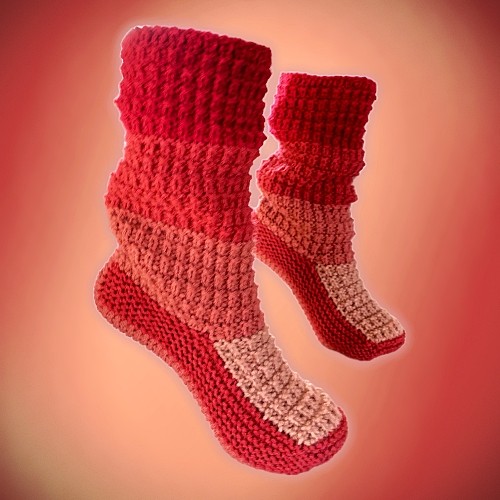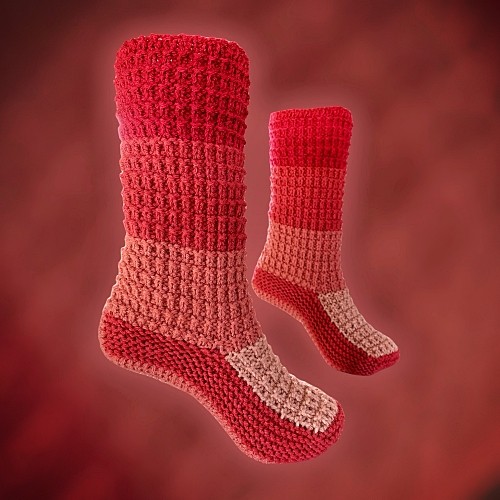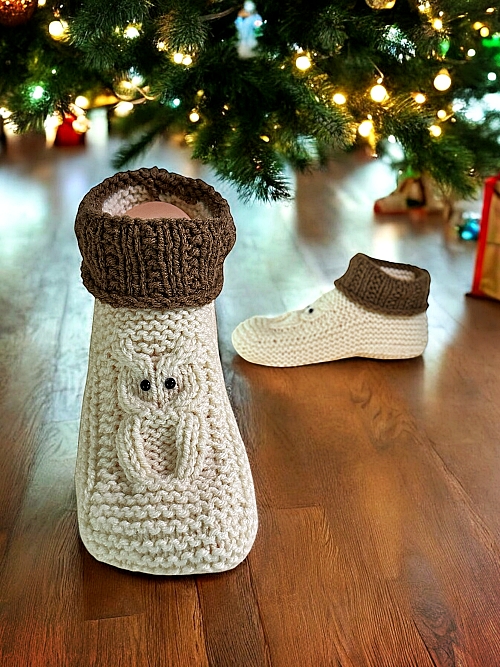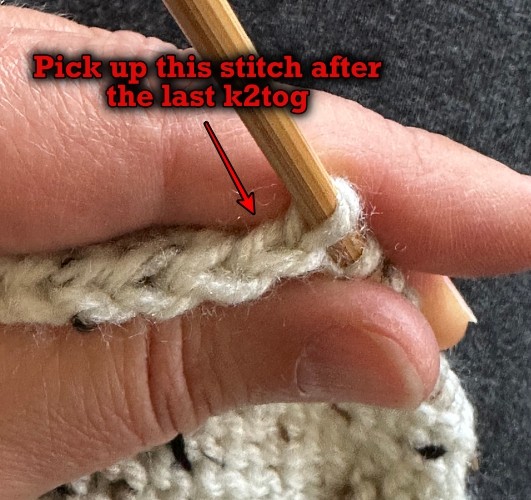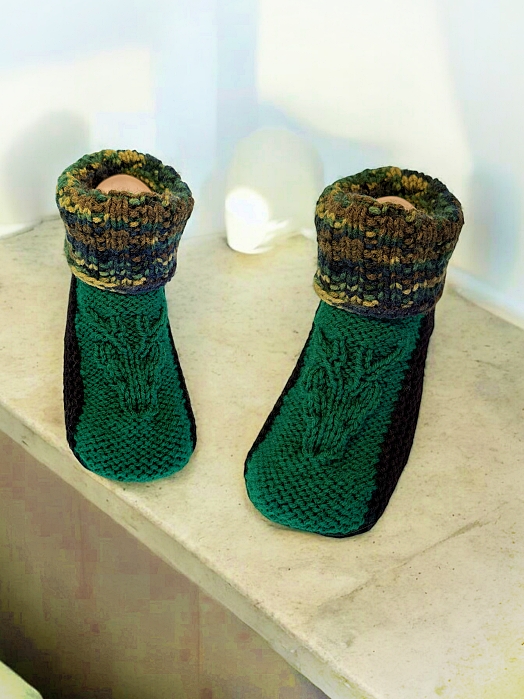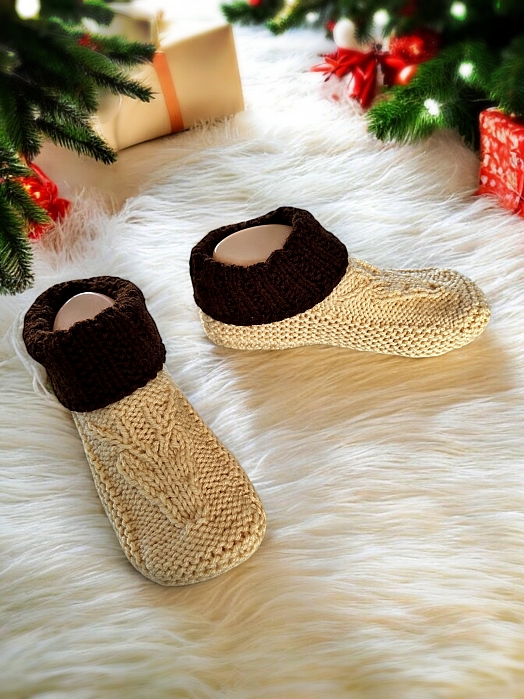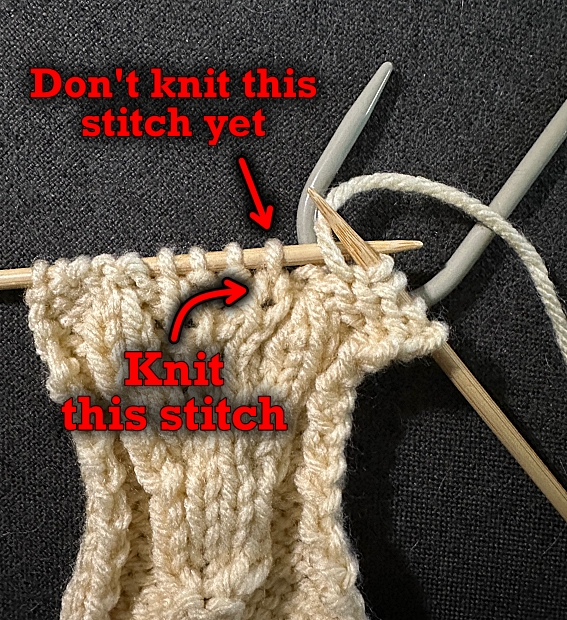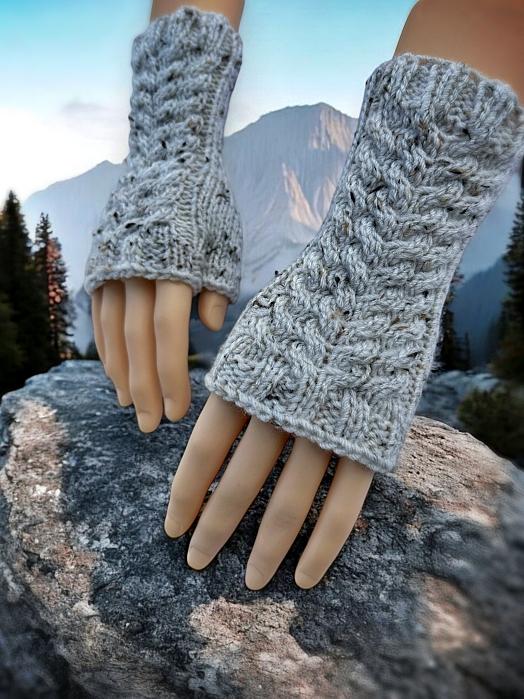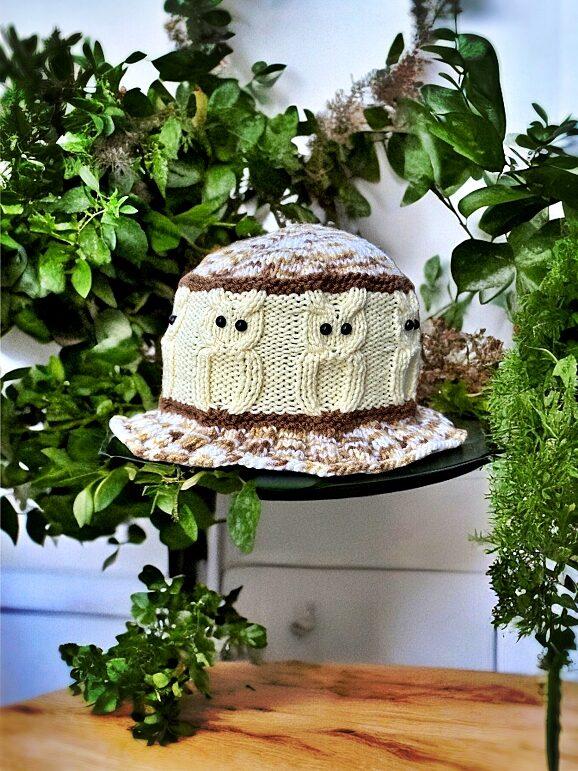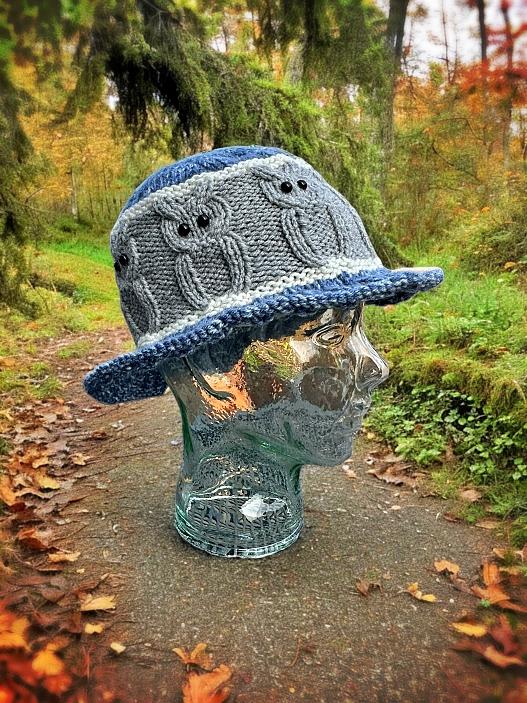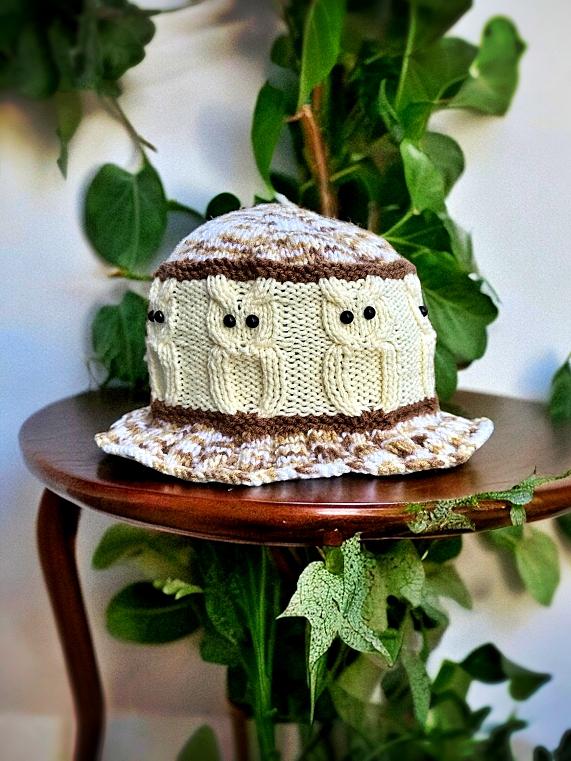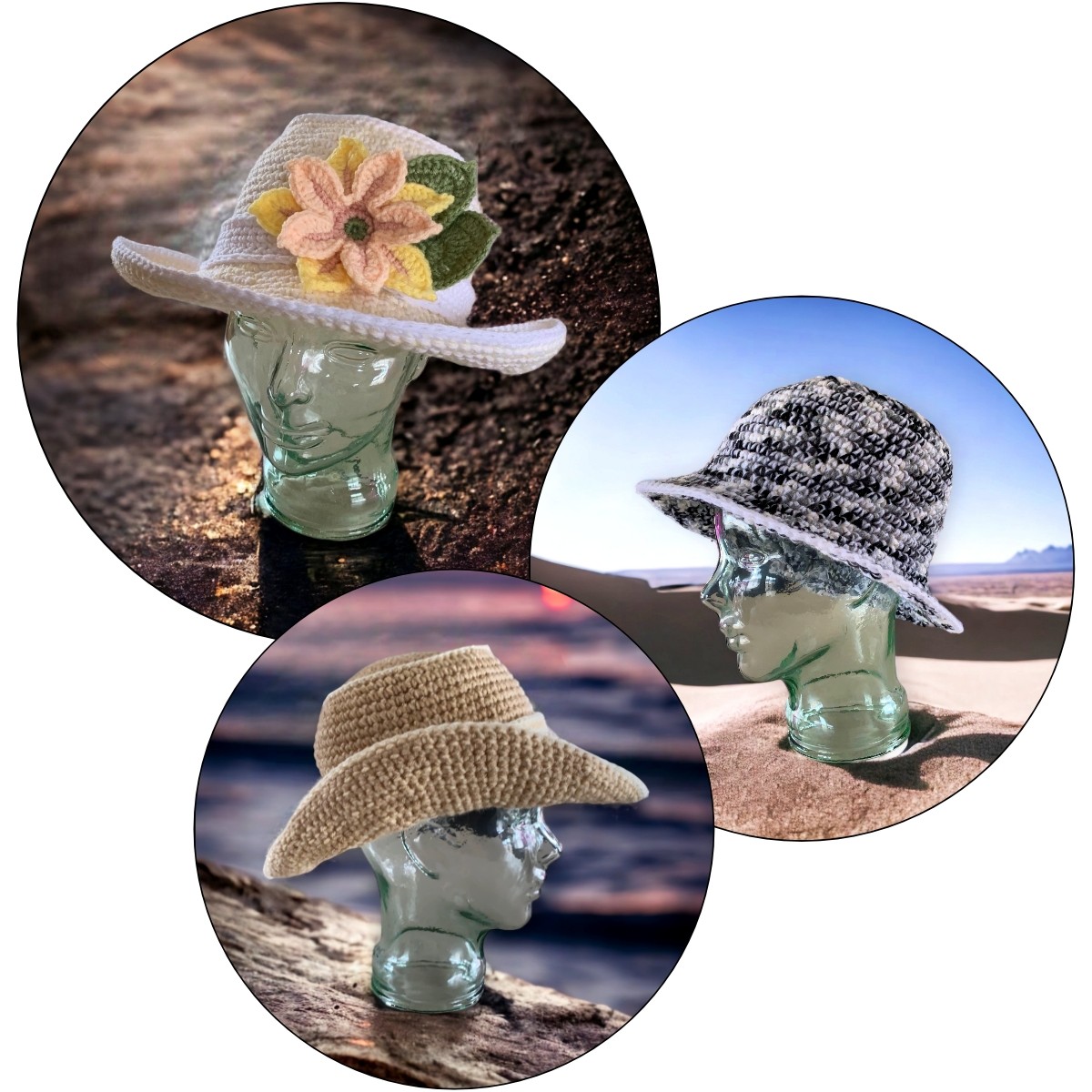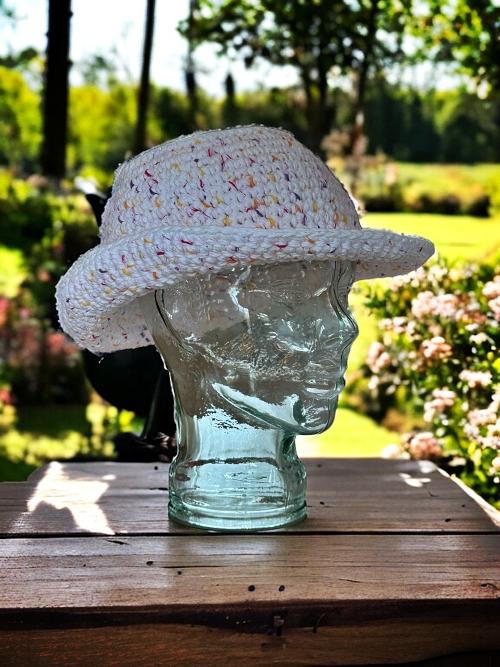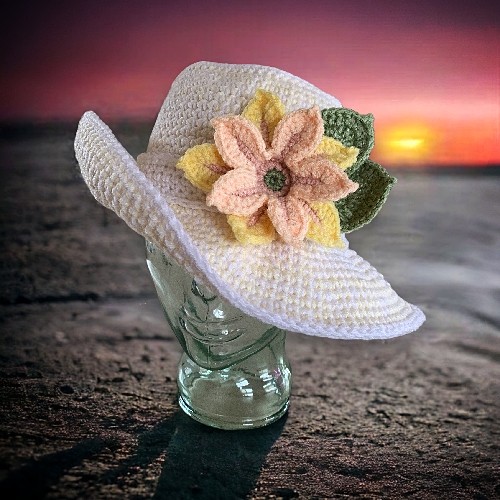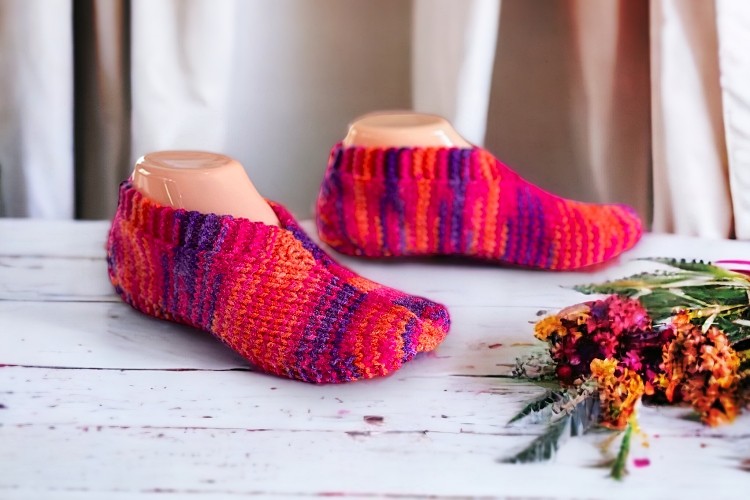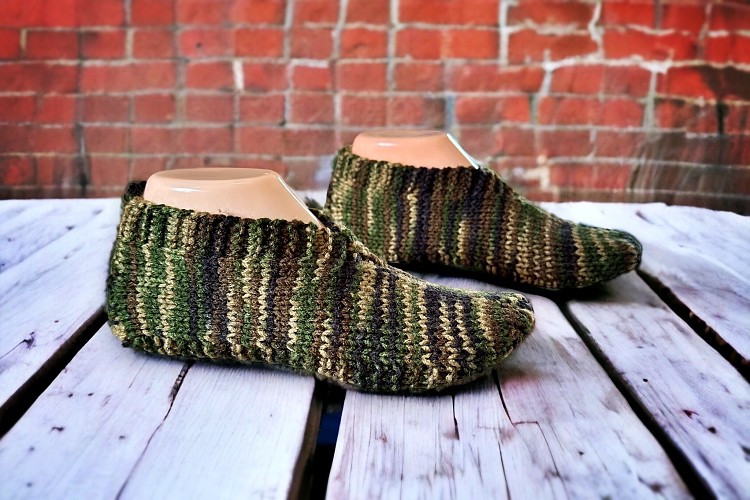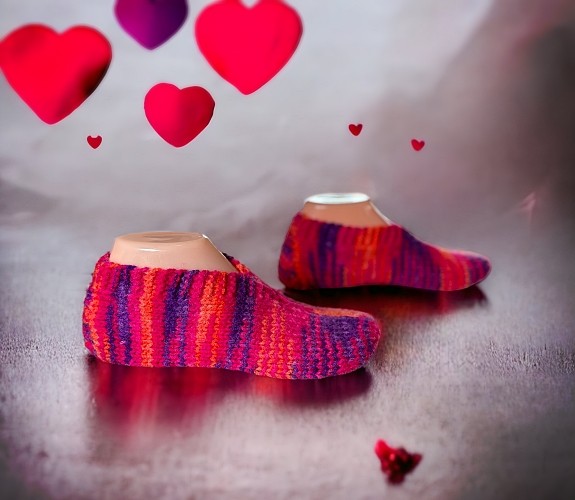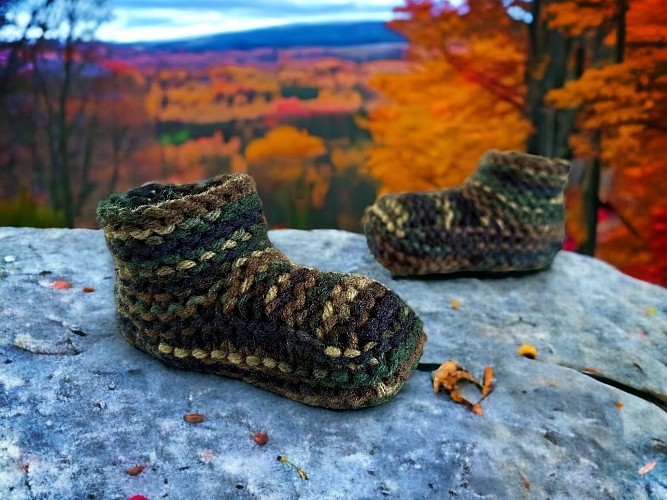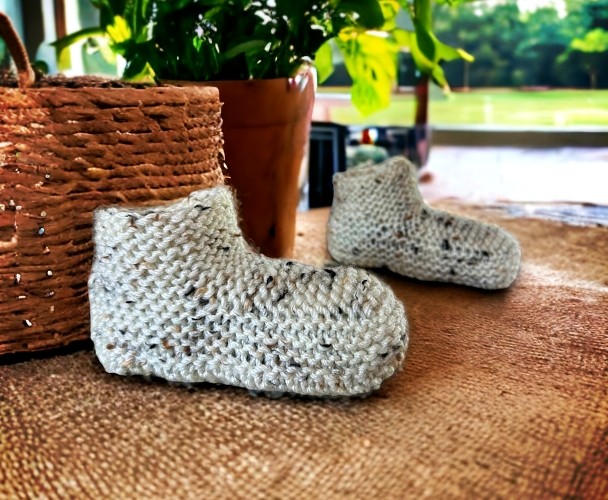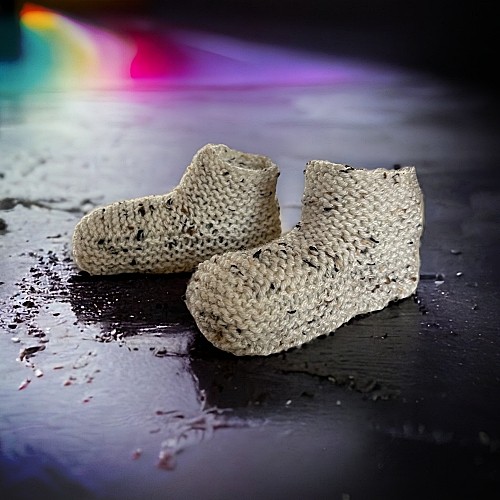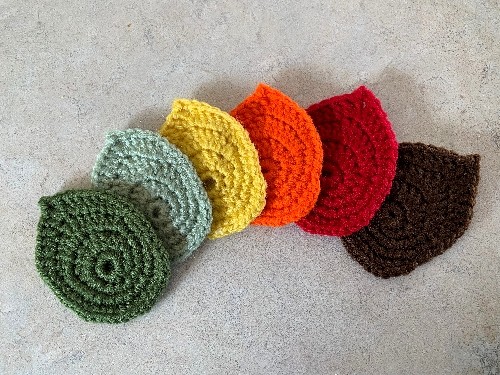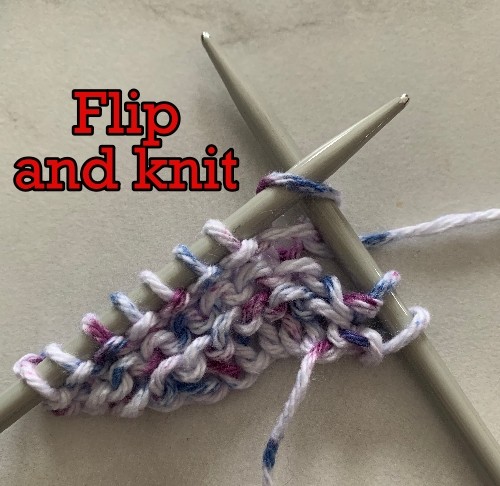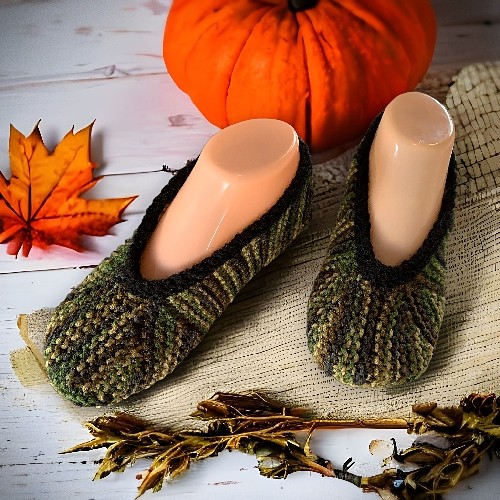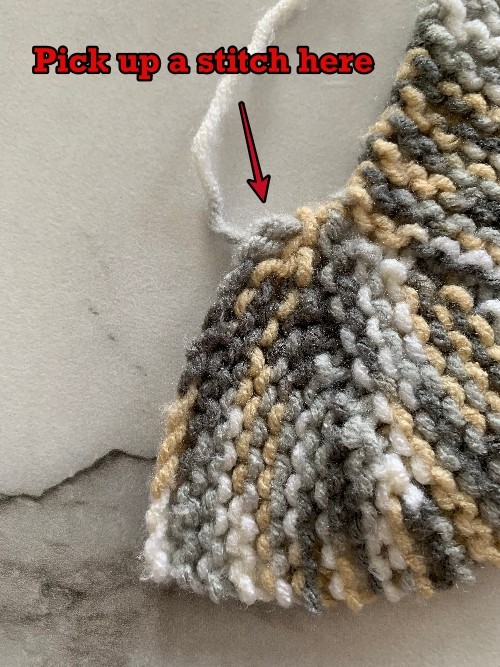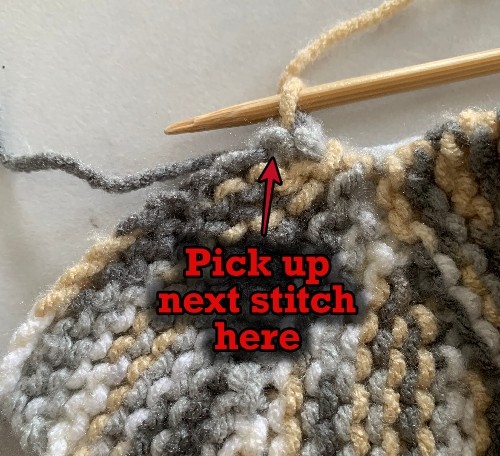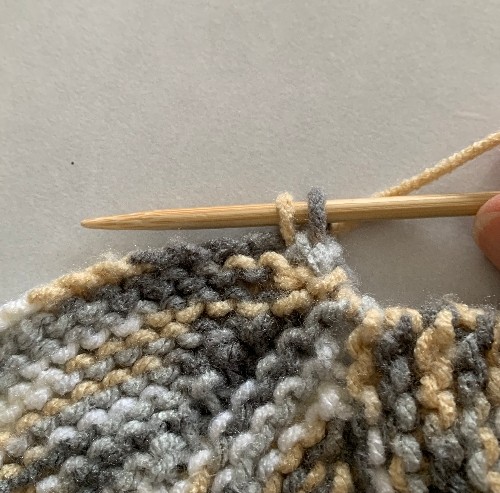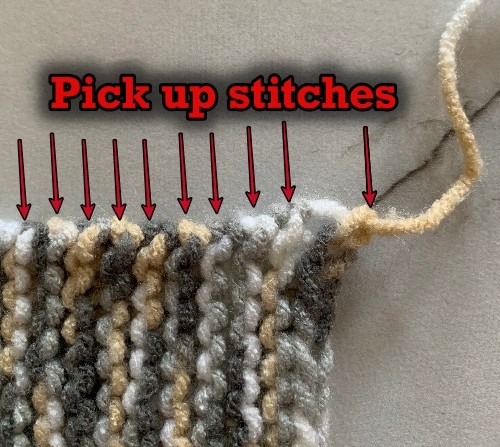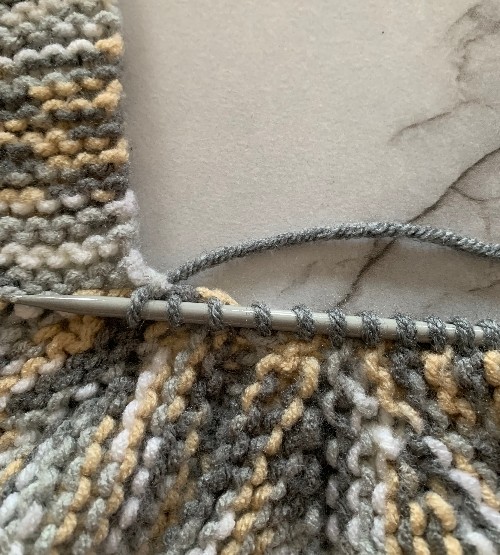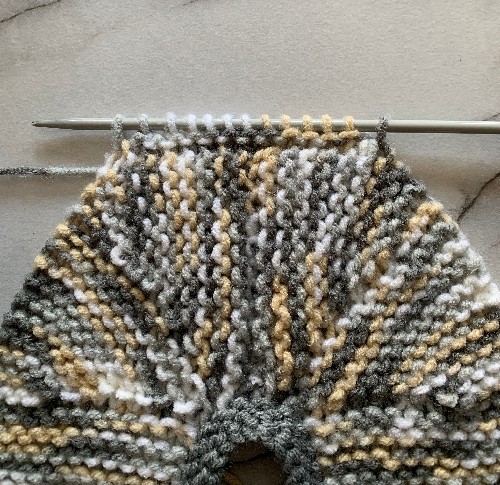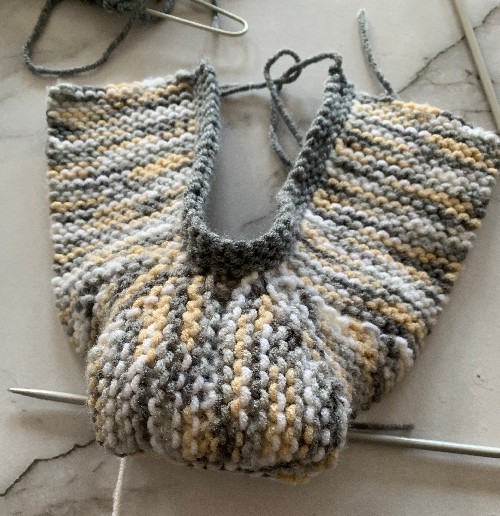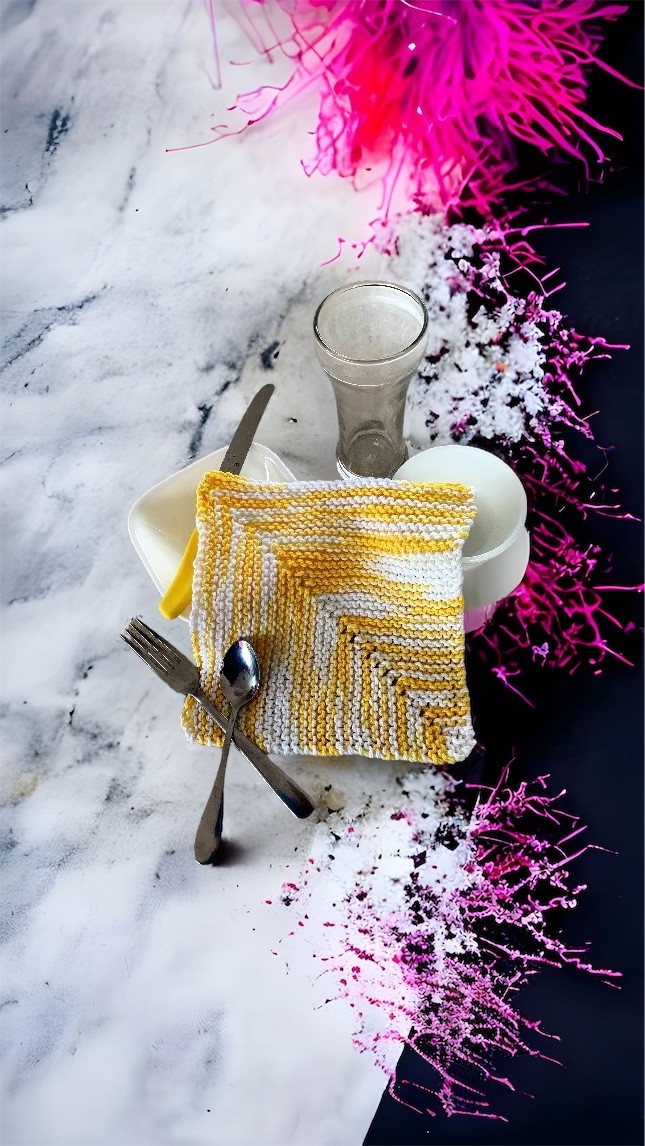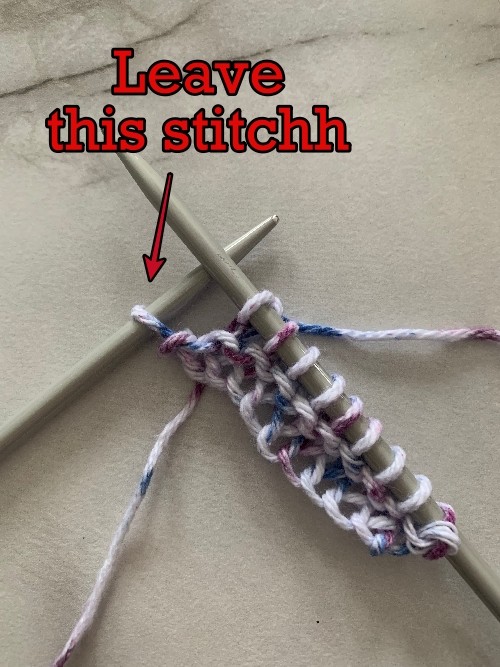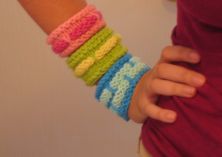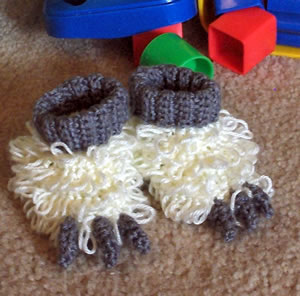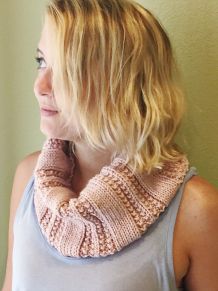
What happens when you cross a slipper with a dishcloth? No, this isn’t a joke. This is exactly what inspired me to design this new slipper. I had recently written and published my latest pattern Textured Easy to Knit Dishcloth Pattern and thought to my self, “That texture is reversible. I bet I could work that into a slipper pattern. But which one?” Then it dawned on me. Because this isn’t a very stretchy texture, it would be slouchy and baggy, but it would have to fit snuggly around the foot to stay on. Then I realized my super popular Free Knitted Moccasin Slipper Pattern does exactly that! And this knitting pattern was born… But enough about the genesis of slipper patterns.
This pattern is written for adult sizes. If there are enough folks that leave a comment requesting child sizes, I’ll happily do it. It involves a lot of math and if there is no demand, I don’t want to put all the effort into it for nothing.
Like always, you can find the ad-free, downloadable, printable PDF version of this pattern through all my regular online purveyors of creation such as Ravelry, Etsy, LoveCrafts and of course this website at Adult Moccasin Bootie Slippers – Classic Ugg Style – Knitting Pattern.
Another way to avoid ads and pop-ups, get instant, PRINTABLE downloads of this pattern and others, is by becoming a Member. When you become a Website Supporter at $4/month, you’ll gain access to exclusive member only posts on Buy Me A Coffee. You can download as many patterns as you like for the same $4 each month. You can go to this page to learn more, become a member and support my work… Exclusive Member Area
Loving the free knitting patterns? Then please help support this site. You can learn more by going to my Help Support My Work page and make a small financial contribution. Or, you can use these share links below ?????? and share this and my other patterns through your social media. More eyeballs on my work helps a bunch too.
Things You Need
1 ball of worsted weight yarn (average 260 yard, 5 oz or 141 gram ball will be more than enough). I used Red Heart worsted weight yarn when designing the pattern but any worsted weight yarn will suffice.
2 sets of size 4 mm (US size 6) single point knitting needles.
Tapestry needle to sew in ends. You can also use this handy tutorial to show you how to work in the ends while knitting these slippers.
Gauge
With size 4 mm (US size 6) needles or whatever size you need to obtain the correct number of stitches and rows. Be sure to check your gauge otherwise the sizing won’t be correct.
In garter stitch
4” = 16 sts
4” = 40 rows
Sizes (are written as such)
Women’s 6-7 (8-9, 10-11, 12-13)
Men’s 5-6 (7-8, 9-10, 11-12)
To Begin
Cast on 58 (62, 66, 70)
🦉 Row 1 – 2: K1 P1 across.
Row 3 – 4: K across. 🦉
Repeat from 🦉 to 🦉 8 more times. (If you want a longer bootie, make more repeats of these 4 rows.)
Repeat Row 1 – 2 one more time.
Break yarn when completed row 2.
Toe Flap
Next Row: With RIGHT side facing, transfer the first 22 (24, 26, 28) stitches to a stitch holder. Reattach the yarn and K1 P1 across the next 14 stitches (the start of the toe flap). Leave the remaining 22 (24, 26, 28) stitches on the needle unworked.
The following rows are worked back and forth on the 14 toe flap stitches only!
🌸 Next 2 Rows: Knit across.
Next 2 Rows: K1 P1 across. 🌸
Repeat from 🌸 to 🌸 6 (7, 8, 9) more times. You now have 28 (32, 36, 40) rows total for the toe flap.
Break yarn. You’ll have the 14 stitches of the toe flap on your needle and the 22 (24, 26, 28) stitches you left on the needle when you started making the toe flap.
Making the Sides of the Slipper
This is where you’re going to need the extra set of knitting needles. You’ll be knitting back and forth in rows but the turn around of the toe is too tight to use circular needles. For this, you’ll put the 14 toe flap stitches on one of your extra needles. It’s a little unconventional, but it works.
Next Row: With the RIGHT side facing, transfer the 22 (24, 26, 28) stitches from the stitch holder onto one of your needles. Attach your yarn and K2tog the 22 (24, 26, 28) stitches. You will now have 11 (12, 13, 14) stitches on your working needle.
With the working needle, pick up 21 (22, 23, 24) stitches evenly along the edge of the toe flap. (All of these stitches are on ONE needle. (There are now 32, (34, 36, 38) stitches on this needle.)
With another needle, knit the 14 stitches of the toe flap. (14 stitches on this needle)
With another needle, pick up 21 (22, 23, 24) stitches evenly along the side of the toe flap.
With your working needle that has the picked up stitches, K2tog the 22 (24, 26, 28) stitches that are on the non-working needle. You will now have 32 (34, 36, 38) stitches on this needle.
You should now have 3 needles holding stitches with all the points pointing as shown below when laid flat. You also have one spare needle to knit with. You are now going to knit in rows, back and forth with these three needles. Once you finish knitting all the stitches on one needle, move on to the next needle (the point of the needle is right there) until you complete the row.

Knit the next 10 (12, 14, 16) rows
There are 5 (6, 7, 8) ridges on the tip of the toe.
The photo below shows the 5 ridges for the women’s size 6-7 or the men’s 5-6.
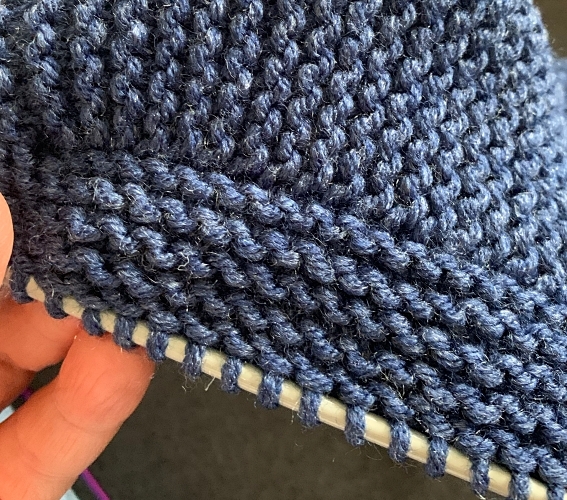
I forgot to take a new photo and reused the photo from another pattern.
The horizontal ridges look the same for you.
Making the Sole
If you need help with the sole, you can watch the video. It starts right where you need it to.
Next Row: With WRONG side facing. Cast off all the stitches from the first needle loosely. You’ll need to pass the last stitch from the first needle over the first stitch of the toe flap stitches (second needle).


Using the same needle that now has one stitch, knit the remaining 13 stitches of the toe flap. Cast off all the stitches from the third needle loosely. Break yarn.
Next Row: With the RIGHT side facing, attach yarn and knit the first stitch of the cast off stitches by the toe flap (cast off stitch on the right by the point of the needle).
K2tog. Knit to the last 2 stitches K2tog. Pick up the cast off stitch by the point of your needle. (14 stitches).
PLEASE NOTE: To make the picking up of the cast off stitches easier, count the number of cast off stitches on one side and count off the same number of cast off stitches on the other side. In other words, count up 32 (34, 36, 38) cast off stitches when picking up the first stitch, work across as written above, count up 32 (34, 36, 38) cast off stitches on the opposite side and pick up a stitch.
Quick tip – wrap the yarn counterclockwise around your needle and turn it down to pull the yarn through the cast off stitch on the right. If you have a hard time doing this, you can also use a crochet hook to pull the loop through and place that loop on your working needle.
You now are working back and forth along the bottom of the foot picking up one cast off stitch on each side as you go.
Next Row: Knit across.
🐿️ Next Row: Pick up the next stitch of the cast off stitches. K2tog. Knit to the last 2 stitches K2tog. Pick up the cast off stitch on the other side of the slipper by the point of your needle. (14 stitches).
Next Row: Knit across 🐿️
Repeat from 🐿️ to 🐿️ down the entire length of the foot. There are equal number of cast off stitches along each side. How many rows varies depending on the size of slipper you’re making. Be sure to end with a completed knit across row.

for this pattern. The centre portion has the textured motif for what you’re making.)

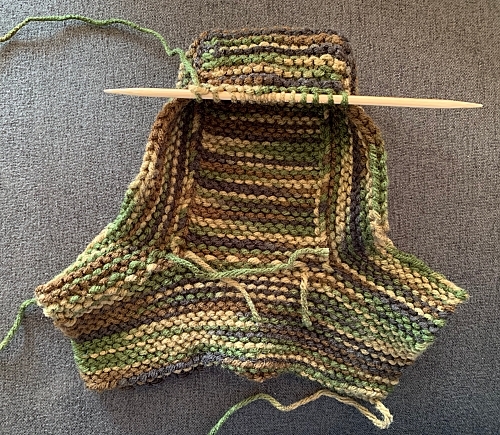

Keep going until you reach the end of the cast off stitches.
♥︎ Next Row: With the RIGHT side facing, pick up a stitch in the row closest to the sole of the slipper. Count how many ridges it is for the size you are making. (There are 5 (6, 7, 8) ridges on the side of the slipper before the cuff pattern begins.)

when making the larger sizes.


K2tog. Knit to the last 2 stitches. K2tog. Count down the same number of ridges on the other side and pick up a stitch in the space beneath it. (14 stitches).
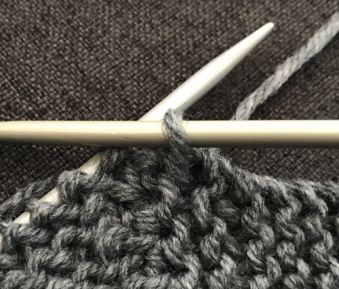
Next Row: Knit across ♥︎
Repeat from ♥︎ to ♥︎ 0 (1, 2, 3) more times. Count down one less ridge for each row where you pick up a stitch along the side of the slipper. Another way to say it is…Work your way up the ridges closer to the cuff pattern when you pick up a stitch on each side when the RIGHT side facing you.
Making the Heel
I recently made a video showing how to do this. It’s how I make a lot of my slipper heels including this pattern. You can watch the video below to help you.
♦︎ Next Row: Count down one ridge less than the previous row and pick up a stitch in the space beneath it. K2tog twice. Knit until the last 4 stitches. K2tog twice. Count down the same number of ridges and pick up a stitch in the space beneath it on the other side.
Next Row: Knit across. ♦︎
Repeat from ♦︎ to ♦︎ until 6 stitches remain. You will start picking up stitches in the patterned cuff on each side. That’s OK!!!
Next Row: Pick up a stitch. K2tog 3 times. Pick up a stitch on the other side.
Next Row (wrong side): K2tog K1 K2tog.
Next Row: Knit the 3 sts together.
Break yarn leaving a length of yarn long enough (12ish inches) to sew up the remaining seam.
Make another slipper.
Yes, they do look a little boxy when they’re done and not on a foot. The stretch of the garter stitch on the sides and the sole allows these slippers to stretch around the contours of any foot easily.
More of my stuff on Etsy:
You can make a widget like this for your blog or website, too.
Instructions are on my website here: How to Display Etsy Items on Your Website
Hints and Tips
If you want a longer cuff at the top, work more repeats of the first 4 rows than stated at the beginning when you cast on. The red striped slippers have approximately twice the number of repeats as written. The purple slippers have the exact number of repeats as written.
If you want to fold the slipper and create a cuff, sew the seam on the wrong side as you usually would.. Work your way down until a little less than half way. Sew the rest of the seam on with the right side facing. You’ll have a nearly invisible seam if you do this. See the photo below.

When picking up stitches from the cast off row, be sure you’re really moving on to the next cast off stitch! It’s an easy mistake to pick up a stitch in a stitch you previously picked up. If in doubt, give the needle holding the stitches a bit of a tug. You’ll see the yarn move slightly at the very back, closest to the needle. Pick up a stitch at the NEXT cast off stitch.
If you don’t have the same number of stitches on both sides when you are forming the sole, you may have picked up a stitch twice in one stitch or missed one. Don’t worry! This is fixable. You can skip one cast off stitch if you need to make it even, or pick up a cast off stitch twice on the other side. There’s enough stretch in the slipper that any puckering this causes won’t be overly visible if you’re off by a stitch or two.
To speed up finishing the slippers and not have so many ends to sew in, hold the yarn ends to the back of your work as you knit. I have a tutorial on my website at KweenBee.com that shows you how. You can search my website for the title How to Work in the Ends While Knitting – KweenBee.com You have to add KweenBee to the title to get my how-to when doing a search through your preferred search engine.
Abbreviations
k – knit
p – purl
k2tog – knit 2 together
st – stitch
sts – stitches
Like all of my patterns you have my permission to sell and/or give away the slippers that you make using this pattern. You are NOT permitted to reprint this pattern in any form unless you have obtained my written permission to do so.
If you have any questions, please feel free to leave a comment or send me your questions at kweenbee_crafts@hotmail.ca.
Help Support My Work!
Follow me on Instagram, Twitter, Facebook, Pinterest and YouTube. Every follow, subscribe, thumbs up, like, heart and share help increase my popularity on the web and get more viewers to my work. It costs you nothing but helps me sooooo much!
For more printable patterns like this one, support me on Patreon! I’m adding new patterns regularly. As of this printing there are 8 additonal patterns to download for only $4 per month. You can read more about that at www.Patreon.com/JanisFrank






